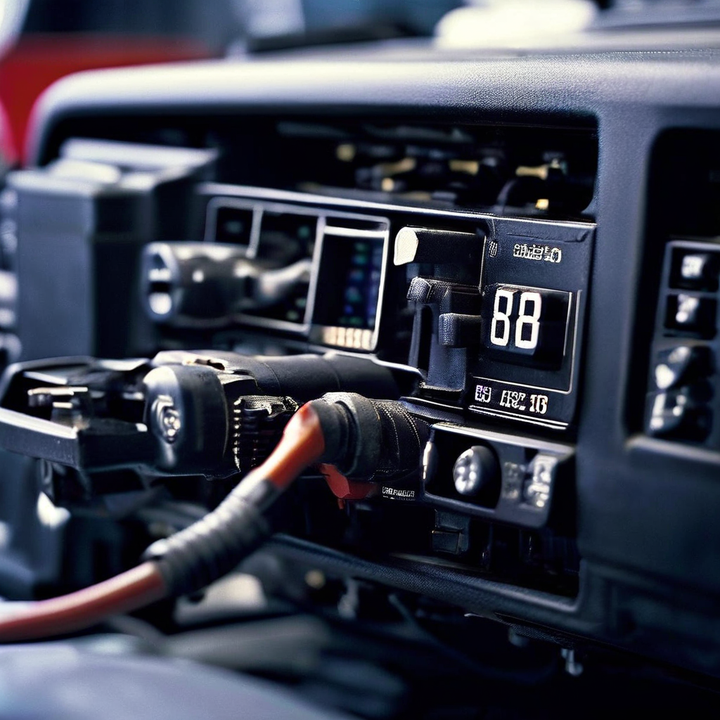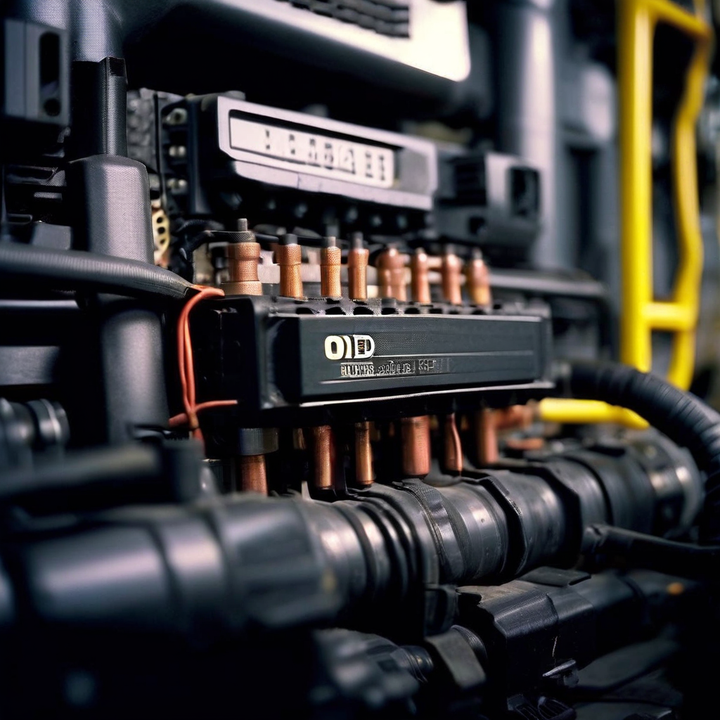


P03C3 is an OBD-II trouble code that indicates the engine control module (ECM) has detected abnormally high cylinder pressure in cylinder #5 of the engine. This code can be triggered by several potential issues related to the combustion process or mechanical problems in that specific cylinder.
Before we dive into the nitty-gritty details, let's first grasp the essence of the P03C3 code. This diagnostic trouble code is a warning signal from your vehicle's on-board computer, alerting you that something is amiss with the pressure levels in cylinder 5.
Now, you might be wondering, "Why is cylinder pressure so important?" Well, my friends, proper cylinder pressure is crucial for efficient combustion and optimal engine performance. When the pressure in a cylinder deviates from the expected range, it can lead to a host of issues, including:
Reduced fuel efficiency
Increased emissions
Potential engine damage if left unchecked
| Issue | Explanation |
|---|---|
| Reduced Fuel Efficiency | Improper cylinder pressure can disrupt the combustion process, leading to incomplete burning of fuel and decreased fuel economy. |
| Increased Emissions | Abnormal combustion can result in higher levels of harmful emissions, such as unburned hydrocarbons and nitrogen oxides. |
| Potential Engine Damage | Excessive cylinder pressure can put strain on various engine components, potentially leading to premature wear or even catastrophic failure if not addressed promptly. |
As a seasoned mechanic, I've encountered numerous causes for the P03C3 code, and let me tell you, they can be as varied as the makes and models of vehicles themselves. Here are some of the most common culprits:
The cylinder pressure sensor is responsible for monitoring the pressure levels in each cylinder, and when it starts acting up, it can send false alarms or fail to detect actual issues. A faulty sensor is often one of the first suspects when troubleshooting the P03C3 code.
Worn Piston Rings
Damaged Valves
Stuck-Open Injector
Mechanical issues can contribute significantly to excessive cylinder pressure. Imagine a piston trying to compress air and fuel with worn rings – it's like trying to hold water in your hands; the pressure just can't be contained properly. Damaged valves or a stuck-open injector can also disrupt the combustion process, leading to abnormal pressure levels.
Faulty Spark Plugs
Ignition Coil Issues
Wiring Problems
The ignition system plays a crucial role in the combustion process, and any faults within this system can lead to misfiring or abnormal combustion, resulting in high cylinder pressures. Faulty spark plugs, ignition coils, or wiring issues can all contribute to the P03C3 code.
Clogged or Leaking Injectors
Improper Air-Fuel Mixture
The fuel system is responsible for delivering the correct amount of fuel to each cylinder, and any issues with this system can wreak havoc on the air-fuel mixture and, consequently, the cylinder pressure. Clogged or leaking injectors are common culprits, as they can disrupt the delicate balance of air and fuel required for proper combustion.
Incorrect timing of the ignition or fuel injection systems can throw the entire combustion process out of whack, resulting in excessive pressure in one or more cylinders. Proper timing is essential for efficient and controlled combustion, and any deviations can lead to the dreaded P03C3 code.
Now, as a mechanic, I know that diagnosing the P03C3 code can be a bit of a detective game. It's like piecing together clues from various sources to uncover the true culprit. Here's a step-by-step guide to my diagnostic process:
Retrieve Freeze Frame Data: I always start by retrieving the freeze frame data from the vehicle's computer. This data provides a snapshot of the engine's operating conditions when the code was triggered, giving me valuable insights into the potential causes.
Visual Inspection: Next, it's time for a good old-fashioned visual inspection. I'll carefully examine the area around cylinder 5, looking for any signs of damage, leaks, or loose connections that could be contributing to the issue.
Cylinder Pressure Sensor Test: I'll perform a resistance test on the cylinder 5 pressure sensor to ensure it's functioning properly. If it's faulty, well, that's one mystery solved.
Compression Test: A compression test is a must in these situations. By checking the compression in cylinder 5, I can determine if there are any mechanical issues, like worn piston rings or damaged valves, that could be causing the excessive pressure.
Ignition System Inspection: I can't overlook the ignition system either. I'll inspect the spark plug, ignition coil, and associated wiring for cylinder 5, making sure everything is in tip-top shape.
Fuel System Inspection: The fuel injector for cylinder 5 is also a suspect. I'll check for clogs or leaks that could be disrupting the air-fuel mixture and contributing to the high cylinder pressure.
Timing Verification: Finally, I'll verify the timing of the ignition and fuel injection systems for cylinder 5. Incorrect timing can be a real party pooper when it comes to proper combustion, so it's crucial to ensure everything is in sync.
Once I've identified the root cause of the P03C3 code, it's time to roll up my sleeves and get to work. Here's a breakdown of the potential repair procedures:
| Repair Procedure | Description |
|---|---|
| Cylinder Pressure Sensor Replacement | If the sensor needs to be replaced, I'll swap it out with a brand-new one, following the manufacturer's instructions to a tee. |
| Mechanical Repairs | For issues like worn piston rings, damaged valves, or stuck injectors, I'll carefully repair or replace the affected components. |
| Ignition System Repairs | Faulty spark plugs, ignition coils, or wiring components for cylinder 5 may need to be replaced to restore proper ignition and combustion. |
| Fuel System Repairs | If the injector for cylinder 5 is clogged or leaking, I'll either clean or replace it, ensuring proper fuel delivery and air-fuel mixture. |
| Timing Adjustments | If the timing is off, I'll meticulously adjust the ignition and fuel injection timing according to the manufacturer's specifications. |
But my job doesn't stop there. As a responsible mechanic, I always emphasize the importance of preventive maintenance to my clients. Here are some key preventive measures to keep your engine healthy and prevent the P03C3 code from recurring:
Regular engine oil changes using high-quality oil
Use of high-quality fuel and periodic fuel system cleanings
Replacement of spark plugs and ignition components at recommended intervals
Proper driving habits (avoiding excessive idling, rapid acceleration, or aggressive driving)
Now, I know what you're thinking – "But how much is this going to cost me, mechanic?" Well, let me break it down for you. The cost of repairing the P03C3 code can vary depending on the underlying cause and the extent of the repairs required.
Here's a general cost estimate for various repair scenarios:
Cylinder Pressure Sensor Replacement: $100 - $300
Mechanical Repairs (piston rings, valves, injectors): $500 - $2,000 or more
Ignition System Repairs (spark plugs, coils, wiring): $100 - $500
Fuel System Repairs (injector cleaning or replacement): $100 - $500
Timing Adjustments: $100 - $300
It's important to note that these costs are estimates and can vary based on your location, the specific make and model of your vehicle, and the labor rates of the repair facility. It's always recommended to obtain quotes from reputable mechanics or dealerships for an accurate cost estimate based on your specific situation.
While these costs might seem daunting, remember that addressing the issue promptly is crucial to prevent further damage and potentially more expensive repairs down the line.
As I wrap up this automotive adventure, I can't help but reflect on the joys and challenges of being a mechanic. It's a profession that requires a deep understanding of complex systems, a keen eye for detail, and a willingness to get your hands dirty (sometimes quite literally).
But beyond the technical aspects, being a mechanic is about building relationships with clients and earning their trust. It's about providing peace of mind and ensuring their vehicles are running smoothly and safely.
So, the next time you encounter the P03C3 code or any other diagnostic trouble, remember that there's a dedicated mechanic like me ready to tackle the issue head-on. We're not just fixing cars; we're solving puzzles, one cylinder at a time.
Stay curious, my friends, and never stop learning about the fascinating world of automotive mechanics. Who knows, maybe one day you'll be the one sharing your wisdom with others, just like I'm doing now.
Happy motoring, and may your cylinders always maintain the perfect pressure!
The P03C3 code is a diagnostic trouble code that indicates excessive pressure in cylinder 5 of the engine. It is a warning signal from the vehicle's on-board computer.
The common causes include a faulty cylinder pressure sensor, mechanical issues like worn piston rings or damaged valves, ignition system faults, fuel system problems, and incorrect engine timing.
You can retrieve freeze frame data, perform visual inspections, test the cylinder pressure sensor, conduct a compression test, inspect the ignition and fuel systems, and verify the engine timing.
Repair procedures may involve replacing the cylinder pressure sensor, repairing or replacing mechanical components, fixing ignition or fuel system issues, and adjusting the engine timing.
Regular engine oil changes, fuel system maintenance, ignition system maintenance, and proper driving habits can help prevent the P03C3 code from recurring.
The cost can vary widely, ranging from $100 for sensor replacement to $2,000 or more for extensive mechanical repairs, depending on the underlying cause and labor costs.
Yes, a faulty cylinder pressure sensor that provides inaccurate readings can trigger the P03C3 code, indicating excessive pressure in cylinder 5.
Yes, worn piston rings can contribute to excessive cylinder pressure, as they may not be able to properly contain the pressure during the combustion process, resulting in the P03C3 code.
Yes, a stuck-open fuel injector for cylinder 5 can disrupt the air-fuel mixture and combustion process, leading to abnormal cylinder pressure and triggering the P03C3 code.
Yes, it is crucial to address the P03C3 code promptly, as excessive cylinder pressure can lead to reduced fuel efficiency, increased emissions, and potential engine damage if left unchecked.

Miguel started tinkering with car radios as a teenager, fascinated by the intricate dance of wires and circuits. This passion led him to pursue a career as an automotive electrician. For the past 10 years, Miguel has tackled everything from flickering headlights to mysterious electrical gremlins. He thrives on troubleshooting electrical problems and enjoys sharing his knowledge to empower car owners to understand their vehicles better.



